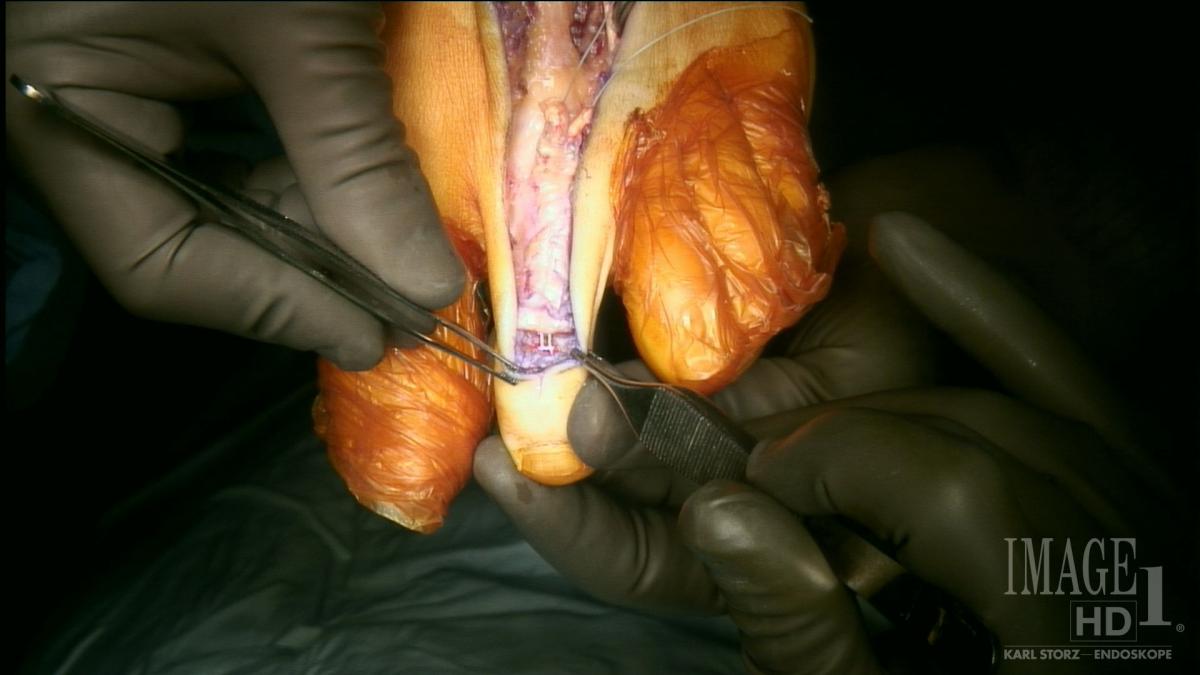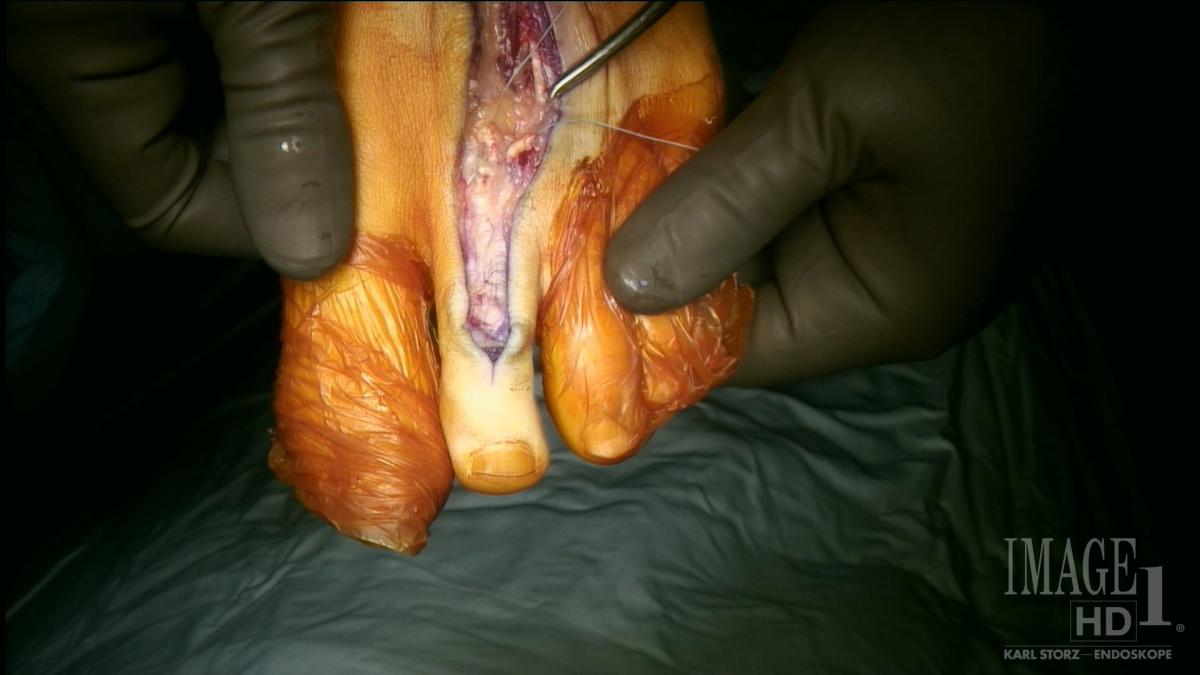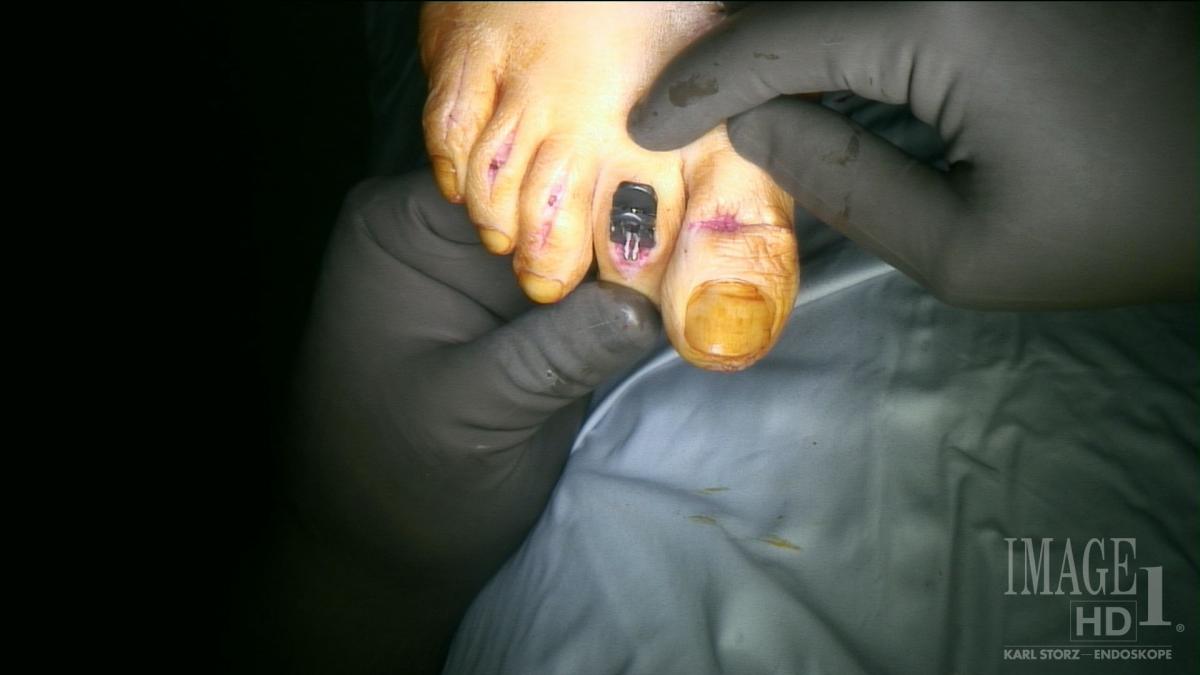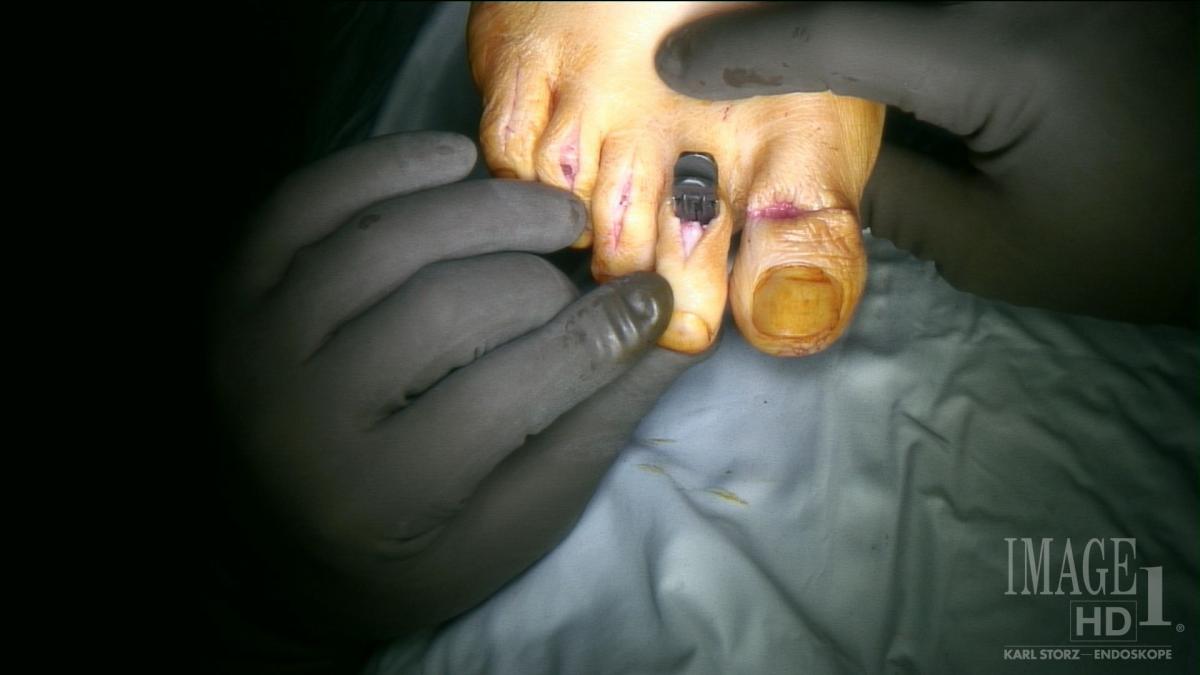ADVERTISEMENT
Intramedullary Hammertoe Implants: Can They Have An Impact?
Can intramedullary implants help improve outcomes with hammertoe repair? These authors discuss the advantages of these implants and offer pearls on reducing the risk of complications.
 Deformities of the lesser digits are a frequently encountered pathology in foot and ankle clinics. The etiology is highly variable but ultimately disruption of the intrinsic and extrinsic muscle balance is responsible for the majority of deformity.
Deformities of the lesser digits are a frequently encountered pathology in foot and ankle clinics. The etiology is highly variable but ultimately disruption of the intrinsic and extrinsic muscle balance is responsible for the majority of deformity.
Hammertoe, a specific digital deformity, is classically defined as flexion of the proximal interphalangeal joints and extension of the distal interphalangeal joints with either a neutral or extended metatarsophalangeal joint (MPJ). The digital posture has been linked to not only pain and an unfavorable cosmetic appearance, but increased risk of callusing, wounding and proximal pathology from the overall musculoskeletal imbalance.1-2 Conservative treatments include shoe gear modifications, crest pads and taping that are often helpful for early or flexible deformities. Rigid deformity or failure of conservative care often necessitates discussion of surgical correction.
Arthrodesis is the gold standard for hammertoe correction. Surgeons perform this by removing the adjacent articular surfaces of the proximal interphalangeal joint to allow osseous fusion. Soule first described the procedure in 1910 and Jones later modified it to utilize a more straightforward dorsal approach.3 In 1940, Taylor added the use of Kirschner wire fixation for stabilization.4 This simple and effective method of arthrodesis remains a steadfast technique in many practices despite its inherent weaknesses.1-4 With modern intramedullary fixation systems, the goal is to address or remove the concerns surgeons encounter with K-wire fixation. Specifically, in a study involving 149 toes in 99 patients, Richman and colleagues noted positive results for intramedullary devices over K-wires for hammertoe fixation.1 In discussing proximal interphalangeal joint arthrodesis for hammertoe correction, Ellington indicated a preference for intramedullary devices in order to avoid complications with K-wires.2
What Advantages Do Intramedullary Devices Offer?
Intramedullary devices have various benefits over standard percutaneous Kirschner wire fixation.5 Typically, the distal interphalangeal joint is not violated with placement of most intramedullary systems despite their similar dissection and approach in comparison with K-wires. Beyond sparing uninvolved joints, intramedullary devices provide multiplanar resistance to rotational forces with a majority of modern intramedullary implants providing a source of compression across the fusion site. This compression is often lacking with standard percutaneous K-wire fixation.
 A recent retrospective review of 136 second metatarsophalangeal joints in 114 patients found improved postoperative radiographic alignment with the use of intramedullary implants in comparison to traditional wire fixation or arthroplasty.5 Additionally, the placement of fixation in the intramedullary canal negates the risk of pin tract infection associated with percutaneous axial Kirschner wire fixation. Elimination of percutaneous fixation alleviates the anxiety associated with pin site care and the appearance of percutaneous pins. The placement of internal fixation lessens the concern for traumatic disruption of the exposed fixation. The use of modern implants often simplifies the postoperative course as indwelling wires typically require four weeks to afford osseous fusion and necessitate frequent dressing changes while impairing mobility.
A recent retrospective review of 136 second metatarsophalangeal joints in 114 patients found improved postoperative radiographic alignment with the use of intramedullary implants in comparison to traditional wire fixation or arthroplasty.5 Additionally, the placement of fixation in the intramedullary canal negates the risk of pin tract infection associated with percutaneous axial Kirschner wire fixation. Elimination of percutaneous fixation alleviates the anxiety associated with pin site care and the appearance of percutaneous pins. The placement of internal fixation lessens the concern for traumatic disruption of the exposed fixation. The use of modern implants often simplifies the postoperative course as indwelling wires typically require four weeks to afford osseous fusion and necessitate frequent dressing changes while impairing mobility.
If given the choice, it is likely patients would elect to not have a pin extruding from their toe. Ultimately, patient satisfaction is most important regardless of radiographic or clinical appearance, and a high satisfaction rate has occurred with intramedullary devices.6-7 In a retrospective study of 30 toes in 10 patients with diabetic peripheral neuropathy and rigid structural toe contracture who had arthrodesis with a one-piece shape-memory nitinol intramedullary internal fixation device for the proximal interphalangeal joint, Roukis cited a 93 percent successful fusion rate with the remaining patients having a stable nonunion.7
A Closer Look At Innovative Hammertoe Devices
 Prior studies have identified nearly 70 different products available over the years with a notable progressive improvement in material quality, design and ease of use for hammertoe implants.8 Early generation products were simple, often composed of static metallic or absorbable composites that acted as positional fixation. A lack of pullout strength and an inability to conform to naturally variable anatomy of the phalanges prompted design improvement. Later generation devices incorporated threads or winged arms to provide additional stability and compression across the fusion site. These designs commonly required storage in a frozen state prior to implantation. This limitation imposed inherent difficulties as it added urgency for insertion once the device was exposed to room temperature and began expansion.
Prior studies have identified nearly 70 different products available over the years with a notable progressive improvement in material quality, design and ease of use for hammertoe implants.8 Early generation products were simple, often composed of static metallic or absorbable composites that acted as positional fixation. A lack of pullout strength and an inability to conform to naturally variable anatomy of the phalanges prompted design improvement. Later generation devices incorporated threads or winged arms to provide additional stability and compression across the fusion site. These designs commonly required storage in a frozen state prior to implantation. This limitation imposed inherent difficulties as it added urgency for insertion once the device was exposed to room temperature and began expansion.
Screw-in devices provided more predictable purchase and compression. However, single piece constructs required an additional incision to the distal tuft for insertion. Two-piece screw-in devices avoided the additional incision but added to complexity, not to mention an increased fear of mishandling such small implant components.
The Lync Hammertoe Correction implant (Novastep) is a prime example of recent advancements in the sector.9-10 The Lync implant is comprised of a single piece of anodized titanium and features tapered proximal and distal wings with barbs that are designed to resist migration when one utilizes this device. The wing pairs create compression across the arthrodesis site thanks to the inherent elasticity of the titanium. When fully engaged, the wings are able to conform to the canals without fear of cortical disruption.
One can simplify setup with cleanSTART quickTUBE (Novastep) containment cylinders. Each quickTUBE contains a single sterilized, ready-to-use implant and is color coded to allow for quick identification of proper size in the operative setting.
The surgical technique is consistent with the “keep it simple” motto. Surgeons should perform standard planar resection of the proximal interphalangeal joint articulating surfaces. Then prepare the proximal and distal phalanges for implantation by centrally drilling first. Lastly, lightly broach the middle phalanx. Then remove the appropriately sized implant from the quickTUBE and secure it with the deployment tool provided with the instrument set. This technique allows a worry-free, touch-free technique with placement of the implant into the proximal and then middle phalanx. Upon release, the wings expand, conforming to the medullary canal and one performs manual compression to ensure apposition.
The Lync Hammertoe Correction implant comes in two different sizes with either 0 or 10 degrees of native flexion to address the most common angular alignments chosen by foot and ankle surgeons. A unique benefit is the availability of a smaller sized implant intended for use in the distal interphalangeal joint with similar features as those we have noted above.
 The Hammerlock 2 Nitinol Implant (DePuy Synthes) is another example of innovation. Its distinctive multi-winged design features biplanar wings that expand in both phalanges, increasing compression and pullout strength.
The Hammerlock 2 Nitinol Implant (DePuy Synthes) is another example of innovation. Its distinctive multi-winged design features biplanar wings that expand in both phalanges, increasing compression and pullout strength.
What is clear is that industry is constantly making efforts to simplify the steps, improve the precision and enhance the speed of the implantation process. The above devices are efficient specifically due to intuitive surgical techniques and the lack of complex instrument trays.
However, as with using any new product, learning curves are inevitable. Preoperative radiographs and the use of X-ray templates allow estimation for sizing and less second guessing while interpreting the often ambiguous intraoperative sizing guides. Adequate exposure is quintessential in all foot and ankle surgery, and ensuring sufficient release of collateral ligaments allows easier distraction and impaction of implant into the phalanges. Drill placement is consistent with placement of a native wire fixation and thus shouldn’t pose difficulty or confusion for experienced surgeons. For implants that require reaming, less may be more in patients with poorer bone stock and prevent unnecessary bone loss.
How To Avoid Complications
As with all implants, there are inherent weaknesses and potential complications. Superficial postoperative infections are among the most common postoperative complications as Roukis determined in a study of intramedullary fixation with a one-piece nitinol implant.7 When an infection involves the bone, extraction of the implant is trivial as the devices are not designed with this in mind. Removal prior to bony fusion is likely to happen without significant hassle. However, once fusion occurs, complete disruption of the bone is required. Use of a non-biodegradable implant is recommended as sinus tract formation is less likely.
 In addition, a single-piece design is best as it removes an additional failure point that may occur with multi-unit devices. If implant removal is ultimately required, in the case of revision or infection, utilizing a standard approach is best. A double action bone cutter allows precise separation of the fusion site while leaving the implant intact. If the implant has an intrinsic bend, it is best to cut at the level of the bend as doing otherwise will impede removal. Upon distraction of the osteotomy, the use of a large clamp firmly fixated to the implant eases the ability to perform the linear pull required to prevent unnecessary damage to surrounding bone. In the case of infection in which bone length may be lost, subsequent fixation could allow a smaller implant.
In addition, a single-piece design is best as it removes an additional failure point that may occur with multi-unit devices. If implant removal is ultimately required, in the case of revision or infection, utilizing a standard approach is best. A double action bone cutter allows precise separation of the fusion site while leaving the implant intact. If the implant has an intrinsic bend, it is best to cut at the level of the bend as doing otherwise will impede removal. Upon distraction of the osteotomy, the use of a large clamp firmly fixated to the implant eases the ability to perform the linear pull required to prevent unnecessary damage to surrounding bone. In the case of infection in which bone length may be lost, subsequent fixation could allow a smaller implant.
The opposite is true when revision is due to malalignment or loss of fixation as these cases may benefit from a larger sized implant. This is where expanding implants, such as the Lync, excel as they can better account for bone loss within the canals. Although we do not often think of intramedullary devices as sources for revision fixation, in the case of failed index wire, a study by Ellington noted that fixation revision with an intramedullary device may be best.2
When implant loosening is happening, one must truly analyze the cause. Perhaps the implant was too small and allowed unnecessary motion due to a lack of osseous purchase. Cortical disruption with drilling, broaching and impaction of the implant are potential pitfalls, increasing the risk of failure. Manual impaction with splinting in the office setting may suffice. However, if failure to form a solid union or satisfactory fibrous union ensues, revision may be required.
Technical difficulty with intramedullary implants is another common concern. Given the lack of osseous real estate, multiple attempts at placement are not a luxury afforded to surgeons, especially when there is osteoporotic bone. Excessive osseous disruption with guide pins and drills will result in a loss of implant purchase, and a potential need to resort to traditional Kirschner wire placement for fixation. One study by Sung and coworkers noted superior alignment postoperatively in patients with implants, and attributed the alignment to the increased need for precision and accuracy when using implants over traditional wire fixation.5 Lastly, with cost being a large concern, implant cost is highly variable and ultimately cost-benefit studies are needed.
In Conclusion
Innovations in foot and ankle surgery are advancing quickly and intramedullary hammertoe implants are at the forefront. Although current research lacks overt evidence of superiority when analyzing complication and fusion rates in comparison to traditional wire fixation, the inherent benefits of such devices clearly demonstrate their place in hammertoe corrective surgery.1 It is our opinion that devices such as the Lync Hammertoe Correction implant and, in some instances, the Hammerlock 2 Nitinol Implant will become the new gold standard in the years to come.
Dr. Fuerbringer is a resident in Podiatric Medicine and Surgery at Gundersen Health System in La Crosse, Wis.
Dr. Hordyk is a resident in Podiatric Medicine and Surgery at Gundersen Health System in La Crosse, Wis.
Dr. Roukis is attending staff in the Department of Orthopaedics, Podiatry and Sports Medicine at Gundersen Health System in LaCrosse, Wis. He is the Past President of the American College of Foot and Ankle Surgeons. Dr. Roukis has disclosed that he is a consultant for Novastep and DePuy Synthes.
References
- Richman S, Siqueira M, McCullough K, Berkowitz M. Correction of hammertoe deformity with novel intramedullary PIP fusion device versus K-wire fixation. Foot Ankle Int. 2017; 38(2):174-180.
- Ellington J. Hammertoes and clawtoes: proximal interphalangeal joint correction. Foot Ankle Clin N Am. 2011; 16(4):547-558.
- Soule R. Operation for the correction of hammer toe. New York Med. 1990; 91:649-650.
- Taylor R. An operation procedure for the treatment of hammertoe and claw-toe. J Bone Joint Surg. 1940; 22:608-609.
- Sung W, Weil L, Weil L. Retrospective comparative study of operative repair of hammertoe deformity. Foot Ankle Spec. 2014; 7(3):185-192.
- Moon J, Kihm C, Perez D, Dowling L, Alder D. Digital arthrodesis: current fixation techniques. Clin Podiatr Med Surg. 2011; 28(4):769-783.
- Roukis T. A 1-piece shape-metal Nitinol intramedullary internal fixation device for arthrodesis of the proximal interphalangeal joint in neuropathic patients with diabetes. Foot Ankle Spec. 2009; 2(3):130-134.
- Canales M, Razzante M, Ehredt D, Clougherty C. A simple method of intramedullary fixation for proximal interphalangeal arthrodesis. J Foot Ankle Surg. 2014; 53(6):817-824.
- Synthes USA, Inc. HammerLock 2 nitinol intramedullary fixation system [brochure]. Available at www.depuysynthes.com .
- Novastep, Inc. Lync hammer toe correction product page. Available at www.Novastep-us.com .











